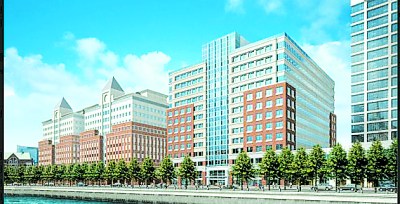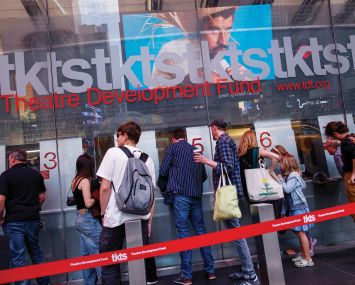Garden State of Mind: Pearson and the Negotiations Behind its Hoboken Deal
By Daniel Geiger February 21, 2012 10:09 am
reprintsWhen Kim Guadagno heard that the media and publishing giant Pearson was relocating from its longtime headquarters in Upper Saddle River, N.J., the first thing she recalled was a promise she had made.
Ms. Guadagno, New Jersey’s lieutenant governor and secretary of state, had been walking months earlier with Dawn Zimmer, the mayor of Hoboken, along that city’s waterfront.

The pair gazed at Waterfront Corporate Center, the two-building complex that has been developed in recent years by the real estate firm SJP Properties. Their eyes fixed on the empty parcel next to the twin properties, the final spot on the site where SJP can erect a planned third office building.
“She told me she wanted to fill that hole in the skyline,” Ms. Guadagno remembered. “I told her I would do what I could to help her.”
Ms. Guadagno knew immediately that Pearson was the perfect candidate for the property. SJP needed an anchor tenant to break ground on the property. But as Ms. Guadagno was about to find out, government officials aren’t always the first ones to be invited into a company’s prospective real estate decision making. By the time she caught wind of Pearson’s decision to move, rumors were already swirling that the company was planning to leave the state for Manhattan.
That scenario was credible. Pearson, which owns the Penguin Group, the world’s largest book publisher, and the Financial Times, has hundreds of thousands of square feet of space in the increasingly trendy Manhattan office neighborhood Hudson Square.
“There was talk that they had a lot of empty space there that they could backfill, moving 1,300 jobs based in New Jersey,” she said. “It was concerning because the operational efficiency they could get by consolidating is something that I knew is always going to be hard to fight with.”
Richard Berzine, Pearson’s real estate broker and consultant, who operates his own real estate services company, confirmed that Pearson hadn’t initially been thinking about the Hoboken site and had been evaluating scenarios that would cut New Jersey out of its real estate equation.
Ms. Guadagno and other New Jersey economic development officials, however, had a potent tool for just such a situation. In 2009, before Gov. Chris Christie was elected and Ms. Guadagno, who was Governor Christie’s running mate, took office, New Jersey passed a package of alluring tax benefits called the Urban
Transit Hub Tax Credit Program, which allows developers to deduct the cost of a large real estate development from their income taxes over a period of time. SJP Properties qualified and had used the benefit for the other two buildings it built at the site. The incentive was what almost lured the online grocery service Fresh Direct to relocate from Queens across the Hudson River earlier this month (eventually the company settled on a move to the Bronx after the city dangled its package of incentives to retain the grocer).
The tax credits would allow SJP the leeway to charge far cheaper rents for the Hoboken building than Pearson could get in Manhattan. Mr. Berzine declined to specify rents in the deal but a source familiar with the terms said that SJP offered the space to Pearson for rates in the $30s per square foot, a bargain for new construction.
“Some other states write a check up front,” Ms. Guadagno said, defending the incentives, which prompted scrutiny in New York in the deal the city made with Fresh Direct. “They don’t get any of the benefit until they actually hire the first person (or bring the first employee to the building). It spurs a $157 million investment in Hoboken.”
But Pearson appeared to step closer to departing New Jersey last summer when it completed a 271,000-square-foot deal at 330 Hudson Street, an office building being developed near its existing locations at 345 and 375 Hudson Street. The lease appeared to hand a setback to Ms. Guadagno’s hopes to retain the company. It soon came to light that Pearson planned to move only a portion of the 475,000 square feet it had in Upper Saddle River to that space, because it also had to serve as a location for employees relocating from Midtown. The company is facing expiring leases at a number of buildings in Manhattan, including 1330 Avenue of the Americas, where it has more than 100,000 square feet of space.
In fact, New Jersey’s incentive package had quietly resonated with the firm.
Mr. Berzine and another broker who worked on the deal with him, Daniel Loughlin, an executive at the real estate services company Jones Lang LaSalle, realized that maintaining a New Jersey outpost would benefit Pearson, and the company was impressed with the economics of the deal.
“We reached a decision that a bifurcated operation would be great because it would continue to provide a convenient location for Pearson employees who were used to commuting to the Upper Saddle River location,” Mr. Loughlin said.
Earlier this month, Pearson signed a 206,000-square-foot deal to anchor Waterfront Corporate Center III, the final, 500,000-square-foot piece in SJP’s development plan on the waterfront. The building is slated to be complete and ready for occupancy in 2014.
About 500 Pearson jobs are still leaving Upper Saddle River to go to Manhattan, but Ms. Guadagno praised the lease that will keep most of the company’s New Jersey operations in state.
“I’m disappointed we’re losing any of the jobs,” she said. “But considering the fact that we faced 1,300 jobs out the door, this is not a bad outcome.”
dgeiger@observer.com


